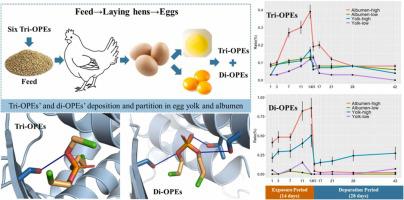Journal of Hazardous Materials ( IF 13.6 ) Pub Date : 2022-08-28 , DOI: 10.1016/j.jhazmat.2022.129858 Yuhan Yin , Nannan Zhao , Liu Yifei , Zhiming Xiao , Xiaolu Liu , Xiaoou Su , Peilong Wang , Xiaomin Li

|
Although organophosphate triesters’ (tri-OPEs) large application and potential toxicity has aroused public concern of human dietary exposure, no study has evaluated their deposition, bioaccumulation and depletion in farm animals yet, limiting our understanding about their behavior and further regulation. In this study, we fed 135 laying hens (control group, low-level group (LLG) and high-level group (HLG)) with chlorinated alkyl-, alkyl- and aryl-tri-OPEs for 14 days and followed by a 28-day depuration period to investigate in ovo transfer. Feeding at environmentally-relevant levels, concentrations of tri-OPEs clearly increased during exposure period and decreased during the depuration period in eggs. Tri-OPEs were 5.95-10.8 times higher in HLG feed than LLG feed, but only 1.41-2.52 times higher in HLG eggs than LLG eggs. Half-lives of tri-OPEs in eggs were between 11.3-106 d and transfer rates were between 0.22-4.22%. As the major metabolites, organophosphate diesters (di-OPEs) were simultaneously studied. Taking di-OPEs into consideration would increase the transfer rate by 64.1%. Both tri-OPEs and di-OPEs mainly deposited in egg albumen. The molecular docking showed that strong combination between OPEs and egg albumen might be responsible for the maternal transfer. The average ratios of di-OPEs to tri-OPEs (Rdi/tri) were 16.7% and 67.2% in LLG and HLG albumen, and were 438% and 517% in LLG and HLG yolk, respectively. Chlorinated alkyl-di-OPEs showed higher in ovo transfer than other di-OPEs. Different distribution patterns of tri-OPEs and di-OPEs were controlled by combination to egg protein, egg formation, metabolic organs and congener-specific properties.
中文翻译:

从饲料到蛋鸡的有机磷酸三酯 (tri-OPE) 及其有机磷酸二酯代谢物 (di-OPE) 的沉积、生物积累和消耗
尽管有机磷酸三酯 (tri-OPEs) 的大量应用和潜在毒性引起了公众对人类饮食暴露的关注,但尚无研究评估它们在农场动物中的沉积、生物积累和消耗,限制了我们对其行为和进一步监管的理解。在这项研究中,我们给 135 只蛋鸡(对照组、低水平组 (LLG) 和高水平组 (HLG))喂食氯化烷基、烷基和芳基三 OPE 14 天,然后用 28 - 一天的净化期在 ovo中进行调查转移。以与环境相关的水平喂养,鸡蛋中三重OPEs的浓度在暴露期间明显增加,而在净化期间下降。HLG 饲料中的 Tri-OPE 比 LLG 饲料高 5.95-10.8 倍,但 HLG 蛋中的 Tri-OPE 仅比 LLG 蛋高 1.41-2.52 倍。鸡蛋中tri-OPEs的半衰期在11.3-106 d之间,转移率在0.22-4.22%之间。同时研究了作为主要代谢物的有机磷酸二酯(di-OPEs)。考虑到 di-OPE,传输率将提高 64.1%。tri-OPEs 和 di-OPEs 都主要沉积在蛋清中。分子对接表明OPE和卵蛋白之间的强结合可能是母体转移的原因。di-OPEs 与 tri-OPEs 的平均比率 ( R di/tri) 在 LLG 和 HLG 蛋白中分别为 16.7% 和 67.2%,在 LLG 和 HLG 蛋黄中分别为 438% 和 517%。氯化烷基二 OPE的卵内转移率高于其他二 OPE。tri-OPEs 和 di-OPEs 的不同分布模式受卵蛋白、卵子形成、代谢器官和同源物特异性特性的组合控制。



























 京公网安备 11010802027423号
京公网安备 11010802027423号